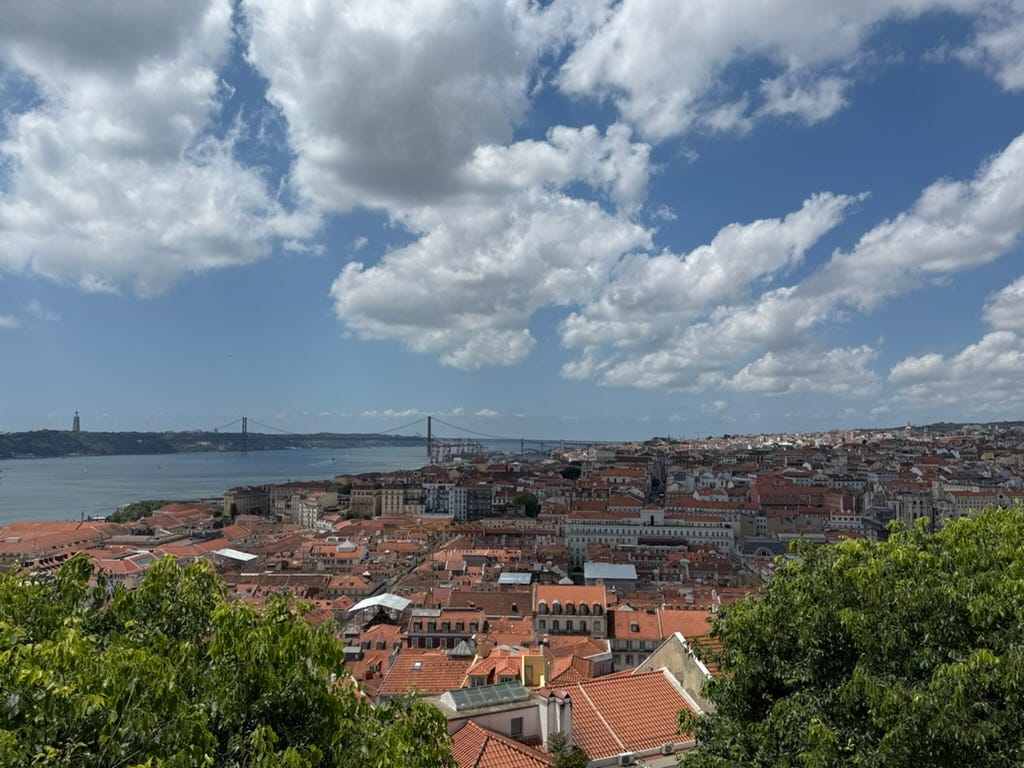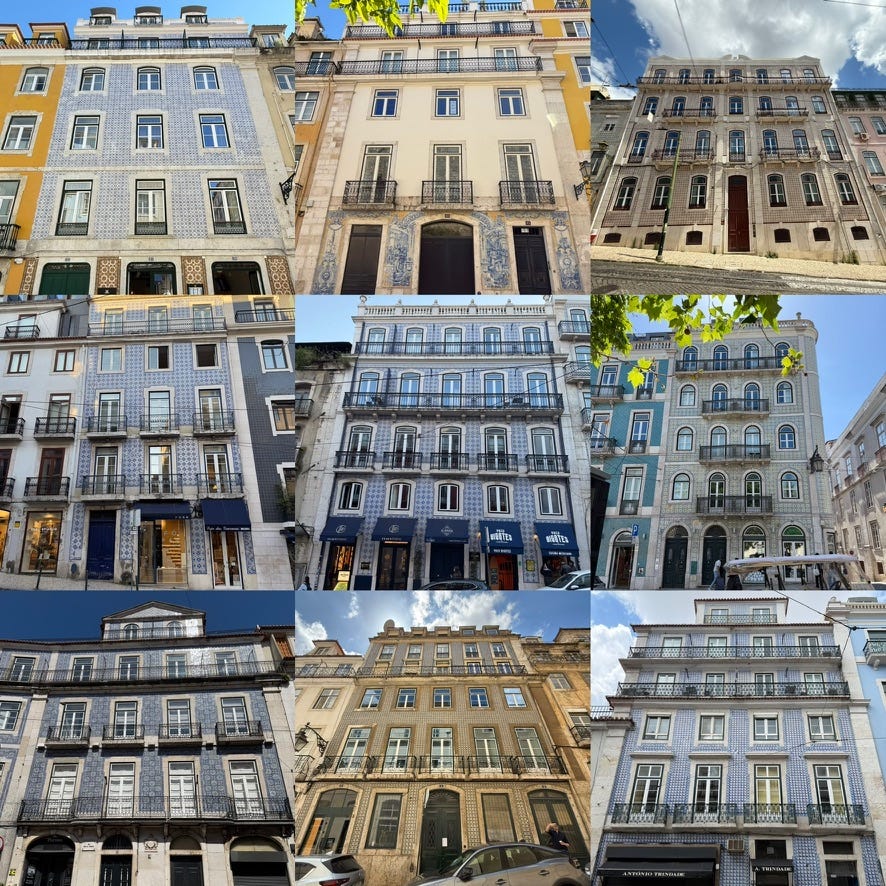The City That Lingers
What Lisbon Gets Right About Public Space
According to Portuguese legend, Ulysses, the legendary Greek hero, sailed to the ends of the known world and founded Ulyssippo, today’s Lisbon, on the banks of the Tagus River. You can imagine the weary warrior-king, adrift after Troy, pausing among the seven hills overlooking the glittering estuary as the sun set over the infinite unknown. Whether myth or metaphor, it’s fitting: modern Lisbon is a city that invites you to linger.
Why does it work so well—and why don’t most American cities feel this way?
Last week, I wrote about Largo do Carmo, the square where the Portuguese dictatorship fell in 1974, marveling at the hidden history of the place and the starring role this quotidian stage played in the most monumental event of the country’s modern history. While travel offers at best a glimpse of local life to the itinerant visitor, it presents no shortage of opportunities to reflect on one’s own home, and so I contemplated public spaces and civic life in America. Lisbon’s public realm is quite different from what we have here.
The city is awash in a vivid otherworldliness: blue-and-white tiles adorn buildings in intricate designs; a violaceous vibrancy crowns the jacaranda trees while magenta bursts of bougainvillea climb across ancient walls and iron fences; its many squares and sidewalks are paved with whimsical patterns; a vermillion bridge slices across a cerulean sky; and yellow trolleys from the 1930s rattle through its streets.
It’s an aesthetic feast, the type of place that beckons you to find a seat and soak it in.
Immediately, Lisbon’s mild weather, steep hills, colorful buildings, and waterfront locale evoke San Francisco. The two cities have similar sizes and densities—and Lisbon's 25 de Abril suspension bridge, painted in the same International Orange hue as the Golden Gate Bridge, was constructed by the American Bridge Company, the same firm responsible for the San Francisco-Oakland Bay Bridge, to which it bears a closer structural resemblance.
There the similarities end.
Lisbon has a completely different streetscape than mostly-gridded San Francisco. The city is a network of narrow streets, pedestrian promenades, staircases—even an urban elevator—opening regularly onto plazas, largos, and little squares.
The squares the streets open onto aren’t decorative voids; they’re designed for life. Restaurants and cafés line their edges, while quiosques offer coffee, wine, and a place to pause. Lisbon’s squares are built for a quick stop or a longer linger, for people-watching and whiling away an afternoon.
In addition to an inviting streetscape, the aesthetic further beckons the wandering flâneur to enjoy the moment. Nearly every sidewalk and plaça is paved with black-and-white calçada portuguesa tiles, chunks of polished limestone and basalt laid by hand, forming beautiful mosaics underfoot. Those tiles are also incredibly expensive to maintain: every time infrastructure work needs to be done, they have to be ripped up and relaid by hand, which is an almost absurd investment in the public realm. But it makes the city distinct.1
Meanwhile, many of the buildings are adorned with blue-and-white tiles of varying intricacies and styles, called azulejos—a word derived from the Arabic for “polished stone.” Dating back to the 15th century, azulejos were initially only found on palaces, civic buildings, and homes of the wealthy, but mass production in the late 19th century made them ubiquitous, supporting the argument that ornament didn’t die because of industrialization—indeed, it often flourished alongside it. These buildings add visual interest to the entire cityscape, further distinguishing Lisbon. They also represent a private investment in the urban aesthetic environment.
Once you escape the crowds of tourists in Baixa and Alfama, the neighborhoods where the main tourist sites and shopping streets are, there are largos and miradouros aplenty where you can simply be. And that’s really the charm of Lisbon: just being there, without a sense of urgency or utility. Even the American instinct to stay busy succumbs to the gentle lull of the city. Back home, lingering feels like an indulgence; in Lisbon, it feels like the point.
Fortuitously,
shared a fascinating interview with Dr. Arianna Salazar-Miranda about the decline of lingering in American cities. Salazar-Miranda’s research into the evolution of public spaces in Philadelphia, New York, and Boston yields a startling statistic: since 1980, the time people spent in these spaces had declined 50% by 2010, while the speed at which people walk had increased by 15%.The takeaway? We’re lingering less.
While Salazar-Miranda stops short of offering definitive conclusions, she suggests a few possibilities for the decline. She notes that while people were using their phones in these spaces, phone use couldn’t explain why people in general weren’t lingering.2 A more likely possibility is disinvestment in public spaces: people prefer to spend time in places with “amenities like parks, sidewalks and urban furniture, [and] more diverse business establishments.” They also seek out human-scale urban design, in narrower spaces “that are more ‘visually enclosed’ by buildings, walls, trees and other vertical elements.” Salazar-Miranda also speculates that people walk faster because of rising incomes: if time is money, slow walking is a fast way to waste it. Public spaces naturally then become places to pass through, not stay in.
But if we’re lingering less in American plazas, there may be another explanation, one that Salazar-Miranda does not contemplate: many public spaces in American cities have become essentially privatized—not by corporations, but by those with nowhere else to go. The persistent presence of homelessness, public drug use, and untreated mental illness makes many squares and plazas feel less like shared spaces in the civic realm than contested zones.3 Even if the danger is only perceived, the sense of disorder and discomfort is real, so many people simply choose to opt out.
In Lisbon, we discovered many enclosed and well-amenitized spaces—and all of them were shared.
Skeptics might argue that Lisbon’s public life is an artifact of a slower economy. But we saw something else: the many people we overheard speaking Portuguese there included groups of older students, elderly couples dressed to the nines, parents with children, people in work clothes. All of them came and went as if coming to and going from the square was a normal part of life. Only the tourists like us spent the entire afternoon there, possibly crossing the line from lingering to loitering.
More likely, what we experienced was a city whose streets and squares are the platforms for vibrant urban life, allowing for an effortless, everyday urbanism.
Does it matter that Americans linger less? Salazar-Miranda thinks so:
If we shift public spaces away from being places of encounter and towards being thoroughfares, it could potentially hinder the ability of cities to create economic opportunity…On the social side, I think you could imagine this shift affecting the creation of social ties, reducing opportunities for interacting with people from different backgrounds, which we know is important for social capital and social cohesion.
Economic opportunity, belonging, a shared civic life—these are themes we keep coming back to here at City of Yes, the reasons why we care about how the human environment is built. They are the social bricks from which our cities are built, that determine whether we are building places for people to fully live in or merely pass through, to create in or extract from.
Of course, this city of polished stones is not a perfect place.
Despite the grand buildings and plazas, Lisbon did not have a feeling of prosperity; there was graffiti everywhere, contributing to an overall sense of dilapidated beauty. Europeans still haven’t received the message that smoking kills—if not the smoker, then certainly the vibe. We were there in the midst of a national election: political signs hung everywhere, but we saw few signs of civic life. A Portuguese friend suggests the locals are exhausted from fifty years of political duopoly and frustrated by a housing shortage (perhaps universal themes in 2025). Like many other European cities we’ve visited, the city felt like it was resting on its historical laurels, its future unclear.
Still, Lisbon has impressive laurels to rest on.
Lisbon isn’t just beautiful—it’s functional, in the deepest civic sense. It works because people use it, not merely to pass through, but to be where they are. Even if its founding is steeped in mythology, Lisbon is a very real place.
The public realm that we enjoyed there is the stuff of fantasy in many American towns and cities. Meanwhile, in those places that do have public spaces, Dr. Salazar-Miranda’s research shows we’re taking advantage of them less. Investing in the public realm can only achieve so much. Culture and technology are surely playing a role in how we approach the world outside our front door, and perhaps those forces are making it increasingly hard for us to open it. Still, I think cities and towns should build for it. While zoning reform is a necessary—but not sufficient—condition for urban repair, public life won’t return on its own. But it can be invited back, and we should welcome it.
Without it, vibrant American cities will increasingly be the stuff of legends.
Do Salazar-Miranda’s research findings ring true to you? What cities or towns do you think have built the public realm well? Is the public realm fighting against culture and technology?
Notably, they’re also slippery when dry. We had six days of beautiful weather, but navigating the city when wet must be a nightmare for all but the able-bodied. This is not a trivial cost of beauty.
Salazar-Miranda’s data relies on video footage from 2010, before the smartphone era, so it would be fascinating to see how her analysis might change with more current footage.
The causes of and solutions to America’s homelessness problem are complex, but it cannot be solved unless high-opportunity cities liberalize their land-use regimes and build more housing. I’ll save that for a future essay.









Like a lot of European cities, Lisbon's public spaces are "complete destinations" -- they have not just places to sit, but places to eat and use the bathroom. Sometimes just a place to buy a newspaper or magazine. Or a fountain to entertain kids or sit near or meet someone at. It is amazing to me how many American public spaces have just space to sit and nothing else. And then we're like -- why do we have to program these spaces? Why is it only filled with homeless people? Why can't they fund themselves?
I observed similar things in the UK.
On average, people seemed more calm and less rushed. I drove in London and around the Cotswolds. People were patient. No one honked. I get a sense that Americans are more financially stressed than Europeans. Time is money. Many Europeans hang out in coffee shops and restaurants for hours. I got bored myself after a week.
Also, UK does a better job of investing in infrastructure such as roads and parks. I can't remember if I saw one pothole in two weeks. Parks are clean and there aren't homeless everywhere like LA. There are hundreds of miles of public right ways through private lands. It's a different mindset of shared amenities than Americans seem to have.